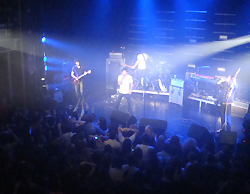A November tour of their homeland by Canada’s Sam Roberts Band played theatre-sized venues throughout the country, with the band’s FOH engineer Phil Hornung was faced with the prospect of using house PA systems in most venues.
In order to maintain consistency of the sound, XTA distributor Sennheiser Canada supplied Hornung with a package of XTA processing options, comprising a C2 compressor, D2 dynamic EQ, E2 parametric EQ, G2 noise gate, GQ600 dual 30 band graphic EQ and DP324 SiDD digital dynamics processor.
“I was looking for a compact outboard package that would allow me to lend some measure of consistency to the sound,” says Hornung. “The XTA package was small, compact and – most importantly – easy to use and interface with local PA systems.”
“The D2 allows me to keep any PA or room overtones that get over-pronounced under control. It’s not for a frequency that you would necessarily want to take out of the mix, but rather one you want to keep from hitting a certain intensity, so I used it for Sam’s lead vocals, chained with one channel of the C2,” he adds.
“The C2 is a really excellent compressor and very transparent. I use it quite gently on the vocal, but it helps to even out the peaks.”
Hornung also used the E2 on vocals, this time inserted on a group that both the lead vocals and the band’s two sets of backing/harmony vocals are routed to.
“The three guys all use the same vocal microphones and they work so well together that I have found it better to EQ all three exactly the same. This lets them blend in with each other by timbre and pitch rather than me pushing or cutting frequencies from their respective inputs,” Hornung continues.
Meanwhile, the G2 gate was used on drummer Josh Trager’s tom toms, allowing Hornung to vary the sound without having to regularly dive for the mixing console’s channel EQs.
“The EQ filter on the gate channels is the most brilliant feature I’ve seen on a gate,” he says. “I feel like it was custom made for me and this band. It’s exactly what I need to get different sounds for different songs.”
Responsibility for evening out the overall system EQ fell to the SiDD and GQ600, which ensured that the band’s highly dynamic brand of rock music was delivered to the audience with ultra-smooth precision.
“For the most part the overall EQ is done with the SiDD,” notes Hornung. “Its parametric equalizer is very accurate and fast to use. I rarely need more than its six bands and, if I do, I have the GQ600, which I usually reserve for making small changes quickly during the show if required. I’ve found the GQ600’s HF trim feature very useful for balancing PA systems without introducing too much phase filtering from using multiple EQ bands.”
Perhaps unusually for a live mix, he also fully harnesses the SiDD’s qualities as a studio mastering mixer, which produced a full-bodied, warm sound, while also controlling any sudden peaks.
“99% of the time we were mixing on digital consoles and using line arrays, which usually resulted in a very accurate sounding mix,” he continues. “But with a band as dynamic as this, it can be tricky to keep things under control.
“I usually set the compressor at around 1.7:1 and set the threshold so that there is nearly always 1-2dB of gain reduction throughout the louder parts of the show. This helps to absorb big impulses from the vocal and snare drum, neither of which is heavily compressed at the input stage. Then I’ll set the limiter threshold 2-3dB above that to fully stop anything from really getting too loud. And I also use the second and third harmonics generators to warm things up a bit.”
For more information:
XTA Website




















